It is not uncommon for the children of immigrants to feel culturally confused. For me, this dissonance is at the root of all that challenges, provokes and inspires me—particularly in the world of food.
I grew up in a traditional Cantonese household in the suburbs of Sydney, the third child of immigrants from Guangdong Province in Southern China. My upbringing was a true clash of cultures. For breakfast, I ate a bowl of noodles; for lunch a Vegemite sandwich (for those not from the Antipodes, Vegemite is a pungent yeast spread ubiquitous in Australian homes). I spoke Cantonese to one parent, broken English to the other. Over the sound of my mother’s wok—which fired and smoked incessantly throughout the day—I daydreamed to the pioneering music of David Bowie, Madonna and Cyndi Lauper.
My mother cooked all day, from sunrise to sunset. She loved to feed. Along with her immaculately and meticulously prepared meals, our senses were treated to the undulating sounds of the stovetop exhaust, the meat being pounded, the wok chuan (spatula) scraping, and the wafting scent of ginger filling the air. The smell of ginger on my mother’s hands is a seminal memory, enveloping me with nostalgia and inspiring me to cook and create in my own way.
Ginger is to the Chinese what garlic is to everyone else. Almost every dish my mother cooks either starts off with or incorporates ginger. For seafood, ginger helps eradicate the piscine odor. In stir fries, ginger flavors the oil before other ingredients are cooked in it and also tenderizes the meat. In jook (congee), ginger is often a healing ingredient.
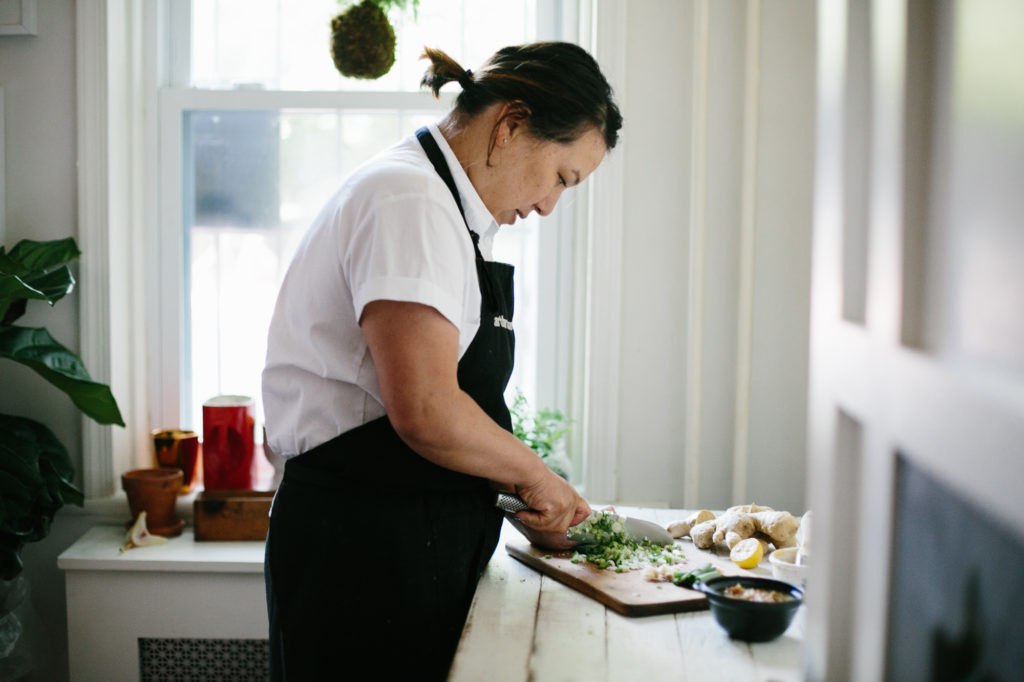
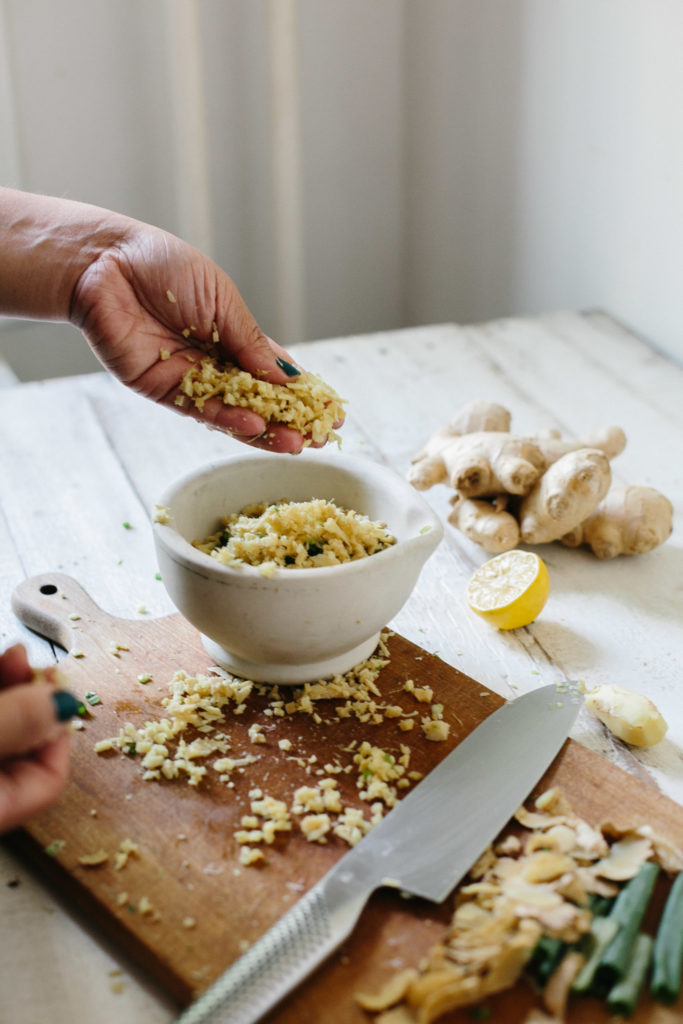
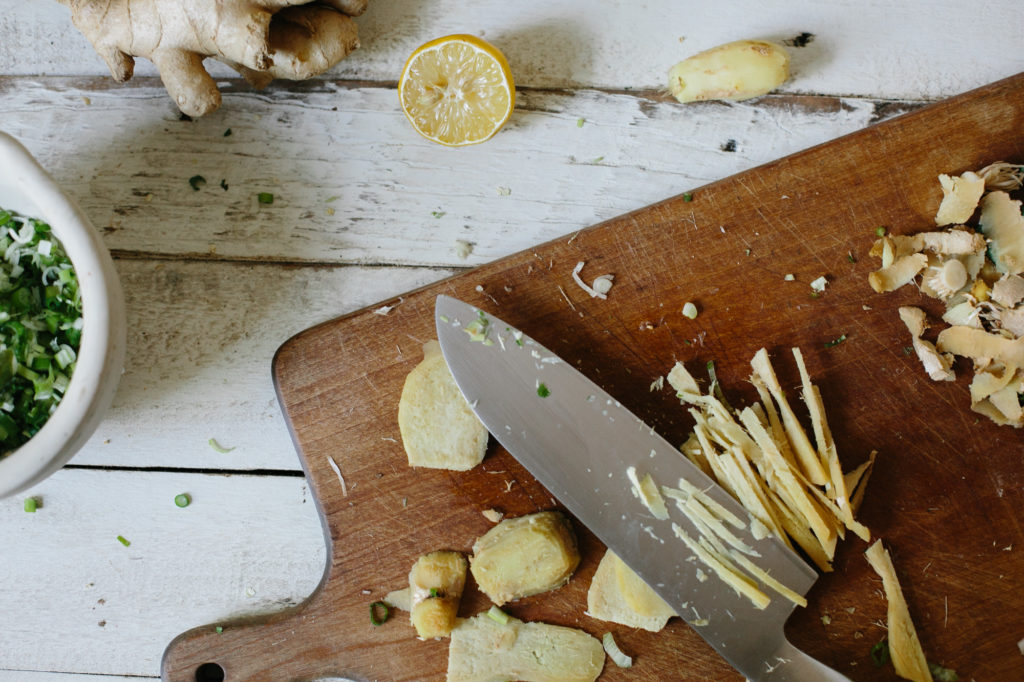
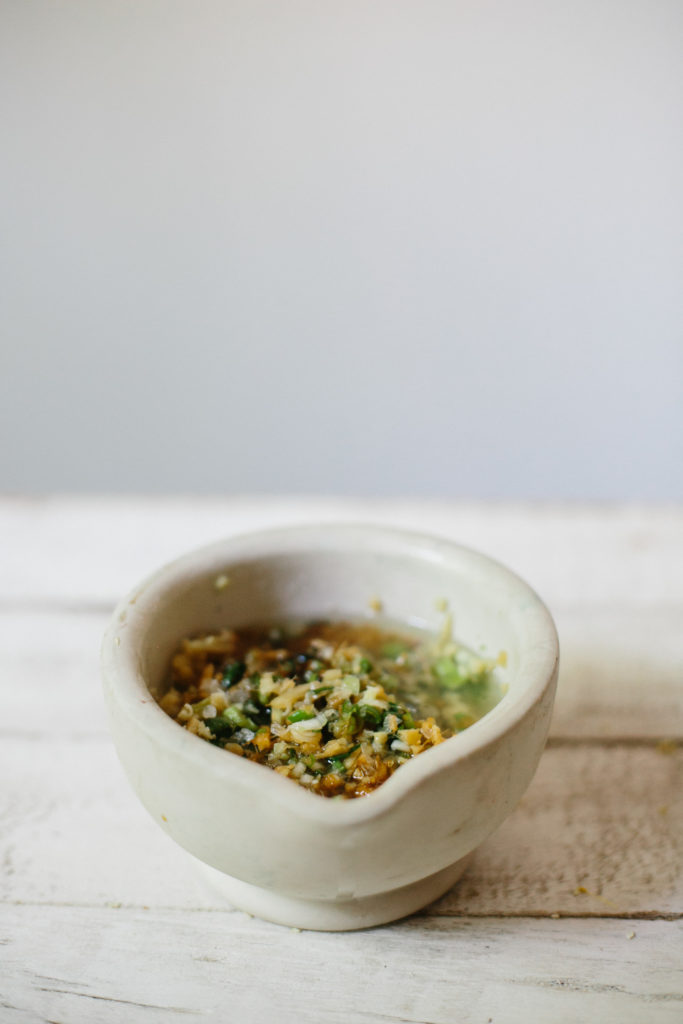
Over the years, I have witnessed the significant role of ginger in Chinese food traditions and rituals. Many Chinese cooks require their dishes to achieve balance in the yin (cold) and the yang (warm). Ginger is said to add heat to a dish and hence, is vital in addressing the nutritional needs of new mothers who are tired and weak (too yin) after pregnancy and childbirth. To regain her yang, the new mother is often fed a dark broth made with pig’s trotters, vinegar, eggs and ginger. My older sister recalls how she panicked every time she detected the scent of this sharply acidic broth in our house, as she thought this meant another sibling was imminent.
After big nights out during my late teens, my mother would nonchalantly bring me a bowl of ginger fried rice for breakfast. Loaded with ginger to ease nausea and spicy as hell, this dish is perhaps the strangest but most delicious hangover food I’ve ever known. Nowadays, it is still the remedy I reach for when my tummy feels topsy-turvy.
For me, the greatest use of ginger is in ginger scallion sauce, my favorite Chinese condiment. In homes, it is most often served with poached chicken; but most Asian kids, including my siblings and I, usually just love to slather it on plain white rice.
In my unlikely career as a plant-based salad-maker, ginger scallion sauce has come to personify my style of cooking—crossbred flavors, with motley textures and assimilated ingredients, drawn from my childhood as an ethnic Australian and my later life as a migrant—firstly in London during the noughties and now in Brooklyn, New York. In the hundreds of salads I have cooked, it is my soba noodle salad with ginger scallion sauce that means the most to me. It is a treasured dish that epitomizes how, in food at least, crossed cultures and disparate origins can exist in harmony and complete balance.
Here, I share my recipe for a basic ginger scallion sauce, and then three different ways to use it. When making this sauce, some cooks like to grate or mince the ginger so it is very fine. For me, I have always preferred to chop the ginger root by hand with a sharp knife—this not only creates more texture, but also allows me the chance to have my very own pair of ginger scented hands.
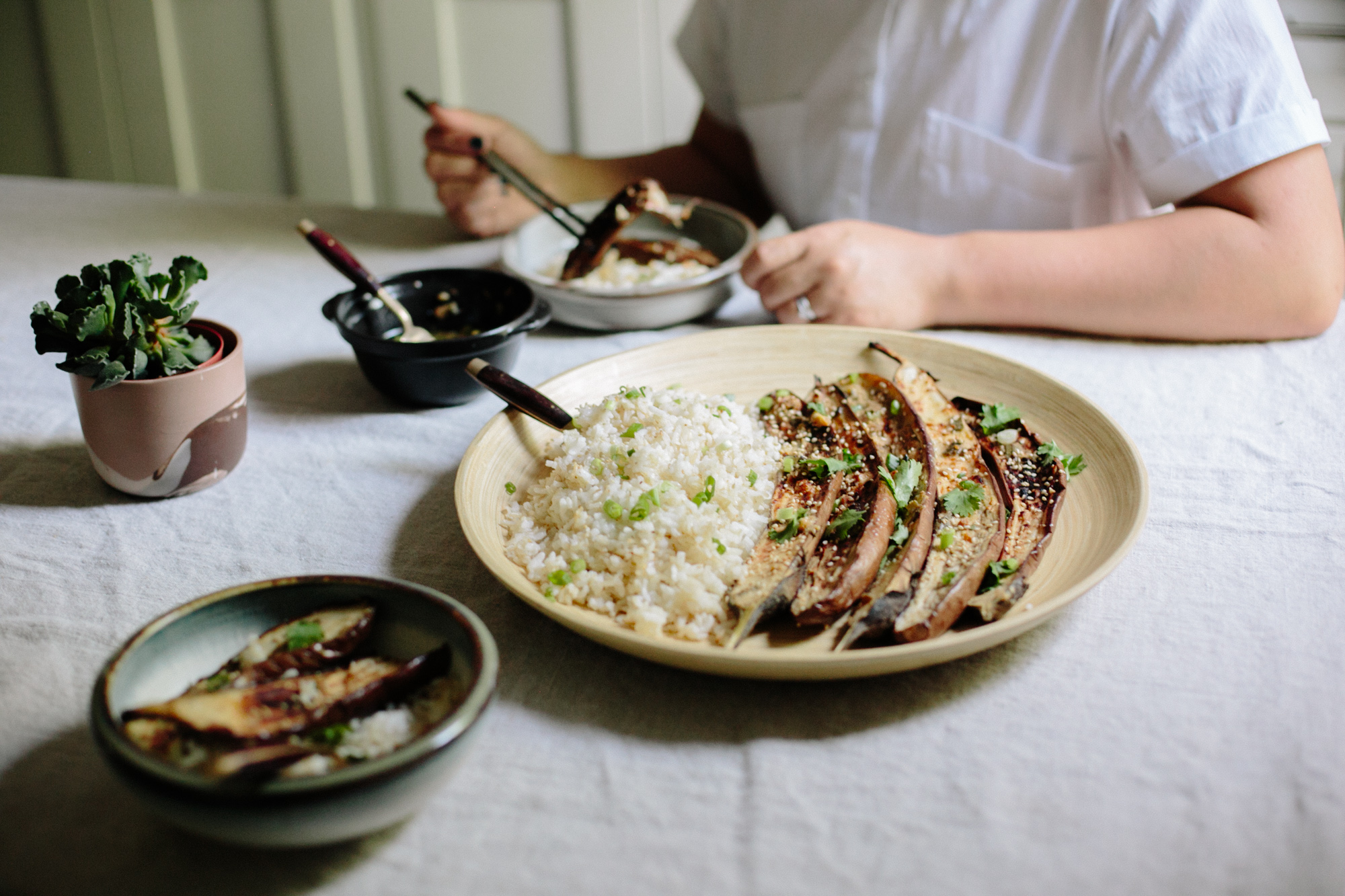
Ginger Scallion Sauce
Makes 2 cups
- 90g ginger, peeled
- 100g (about 8 stems) scallions, finely sliced
- 2 tsp sea salt
- 1 cup rice bran oil (or other neutral oil such as grapeseed)
- 1 tbsp rice wine vinegar
- 1 tbsp soy sauce or tamari (for gluten free)
To begin, finely chop the ginger (or mince it with a food processor).
Combine the ginger, scallions, salt, vinegar and soy/tamari in a bowl. Heat the oil over a medium heat until it just starts to bubble; this should take about 3-4 minutes. Take off the heat immediately and add it to the ginger scallion mix, taking care not to burn yourself, as the oil will spit when it makes contact with the ginger and scallion mix. Allow to cool.
Keep extra ginger scallion sauce in an airtight, sterilized jar in the refrigerator.


Soba Noodles With Shredded Vegetables and Ginger Scallion Sauce
I enjoy this salad chilled. If you can, cook the soba noodles one day ahead and chill overnight in the refrigerator. But if you are short on time, eating at room temperature is fine too.
- Serves 4-6
- 400g (14 oz) soba noodles
- 4 medium carrots, peeled
- 1 small (400g / 14 oz) white or purple cabbage (or a combination of both)
- 4 scallions, finely chopped
- 2 cups ginger scallion sauce
- Sea salt and black pepper
- ½ cup sesame seeds, toasted
Bring a large pot of salted water to the boil, add the soba noodles and cook for 4-5 minutes or until just tender. Drain and refresh under cold running water.
Using a mandolin, food processor or knife, shred the cabbages finely and grate the carrot into long strips. Add the vegetables to the soba noodles and pour over about 2 cups of ginger scallion sauce. Season with sea salt and black pepper, and toss to coat the noodles and vegetables in the sauce. Transfer the salad to a large platter and sprinkle over the toasted sesame seeds.
Ginger Fried Rice With Asparagus and Egg
Cook one or two eggs for each diner, depending how hungry you are. This is the perfect way to use up any leftover rice, especially from Chinese delivery.
Serves 4-6
- 2-3 tbsp grapeseed or other neutral oil
- 4-5 heaped cups cooked brown or white rice (or combination of both), chilled in refrigerator overnight
- 1 cup ginger scallion sauce, plus more to serve
- 500g (14oz) asparagus spears, chopped into ½ inch segments
- Sea salt and black pepper
- 4-6 large eggs
- 2 scallions, finely sliced
In a hot wok or large frypan, heat the 1-2 tablespoons of oil for just a few seconds, then add the brown and white rice. Toss and turn the rice, breaking it up, until it is heated through and there is some golden color and crispy bits. Add the ginger scallion sauce and the asparagus and toss well for 1-2 minutes until the asparagus is just tender (I like the asparagus to retain some crunch). Season with sea salt and black pepper.
In a nonstick pan, add some oil and fry the eggs, sunny side up, until the edges are set but the yolk is still runny (alternatively, you can fry the egg to your individual liking).
To serve, place the rice on a dish and top with the fried egg. Finish with a drizzle of ginger scallion sauce and a scatter of fresh scallions over the top of the egg.

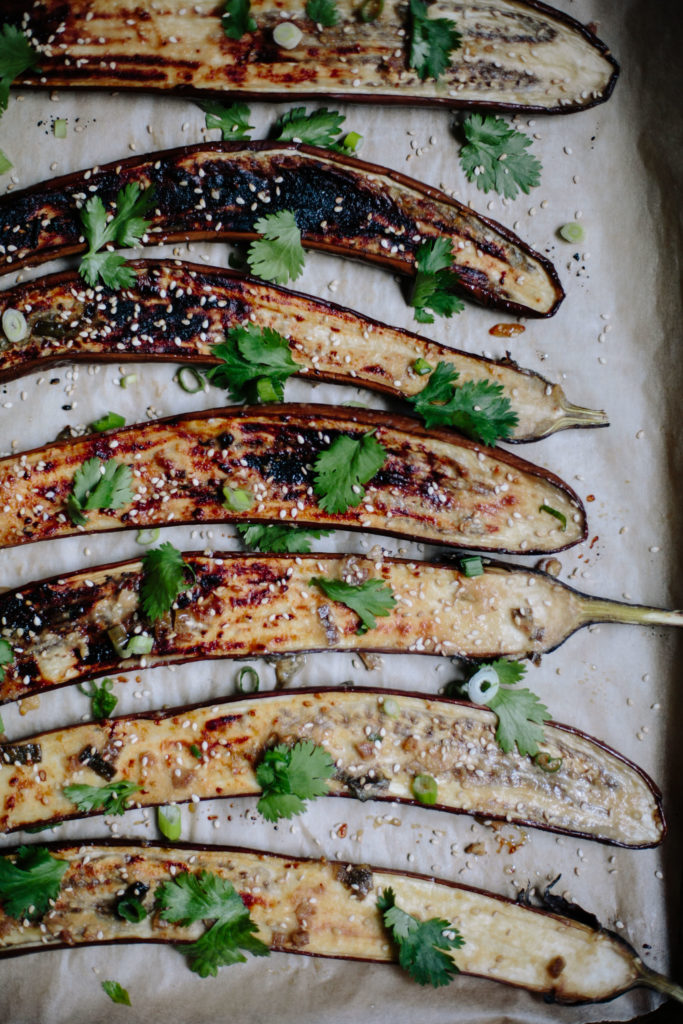
Ginger-Scallion + Miso Glazed Eggplant
Serves 4-6
- 6 Japanese eggplants, halved lengthways
- 1 tbsp sesame oil
- 2 tsp white sesame seeds, toasted
- 2 scallions, finely chopped
- Handful of cilantro leaves, to serve
- Rice, to serve (optional)
For the Ginger Scallion Miso Glaze
- 2 tbsp white miso paste
- 3 tbsp ginger scallion sauce
- Freshly ground black pepper
- 2 tsp white sesame seeds, toasted
Preheat oven to 375˚F/190˚C. Place the halved eggplant onto a large baking tray and brush both sides with sesame oil. Roast in the hot oven for 20-25 minutes, turning over halfway through, until the eggplant is tender. Remove from the oven and allow to cool slightly.
Arrange a rack in the upper third of your oven and switch the heat to broil (grill).
For the glaze, whisk the miso paste with 2 tablespoons of water. When smooth, add in the ginger scallion sauce and half the sesame seeds. With the cut half of the eggplant facing up, smear a generous amount of the glaze onto each eggplant slice. Return to the oven and broil (grill) for 4-5 minutes until the eggplant is golden and starting to char.
To serve, scatter with remaining sesame seeds, fresh scallions and cilantro. Eat on its own as a starter or serve with rice.







Our comments section is for members only.
Join today to gain exclusive access.